
Pudong is a district of Shanghai located east of the Huangpu, the river which flows through central Shanghai. The name Pudong was originally applied to the Huangpu's east bank, directly across from the west bank or Puxi, the historic city center. It now refers to the broader Pudong New Area, a state-level new area which extends all the way to the East China Sea.
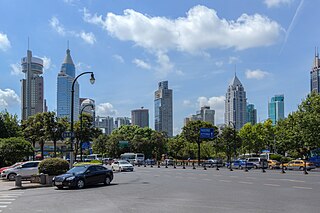
Huangpu District, makes up the eastern part of Shanghai's traditional urban core and is today the most central of Shanghai's 16 districts. Huangpu district is the seat of municipal government, includes key attractions such as The Bund and the Old City God Temple, as well as popular shopping districts such as Nanjing Road, Huaihai Road, and Xintiandi. The Huangpu District is one of the most densely populated urban districts in the world.

The Bund or Waitan is a waterfront area and a protected historical district in central Shanghai. The area centers on a section of Zhongshan Road within the former Shanghai International Settlement, which runs along the western bank of the Huangpu River in the eastern part of Huangpu District. The area along the river faces the modern skyscrapers of Lujiazui in the Pudong District. The Bund usually refers to the buildings and wharves on this section of the road, as well as some adjacent areas. This region has a significant European influence, with the style of many structures most comparable to that of European cities, particularly Gothic, Baroque, Neoclassical, Romanesque, Art Deco, and Renaissance architecture. Additionally, some of the city's top eateries are located there. From the 1860s to the 1930s, it was the rich and powerful center of the foreign establishment in Shanghai, operating as a legally protected treaty port.
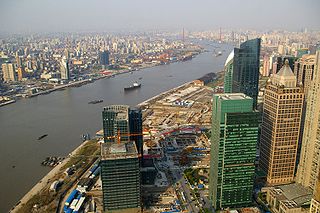
The Huangpu, formerly romanized as Whangpoo, is a 113 km-long (70 mi) river flowing north through Shanghai. The Bund and Lujiazui are located along the Huangpu River.

Puxi is the historic center of Shanghai, China, and remains the home of approximately 48% of Shanghai's residents in an area of 288 km². Puxi is distinguished from Pudong to its east, which is separated from it by the Huangpu River. Despite the growing importance of Pudong's Lujiazui area, Puxi remains Shanghai's cultural, residential and commercial center.

Line 2 is an east–west line in the Shanghai Metro network. With a length of nearly 64 km (40 mi), it is the second longest line in the metro system after line 11. Line 2 runs from East Xujing in the west to Pudong International Airport in the east, passing Hongqiao Airport, the Huangpu river, and the Lujiazui Financial District in Pudong. With a daily ridership of over 1.9 million, it is the busiest line on the Shanghai Metro. The eastern portion of the line, from Guanglan Road to Pudong International Airport, was operated almost independently from the main segment until April 19, 2019, when through service began. The line is colored light green on system maps.

Lujiazui, also known under its Shanghainese name Lohkatse, is a locality in Shanghai, a peninsula formed by a bend in the Huangpu River. Since the early 1990s, Lujiazui has been developed specifically as a new financial district of Shanghai. The decision to earmark Lujiazui for this purpose reflects its location: it is located on the east side of the Huangpu River in Pudong, and sits directly across the river from the old financial and business district of the Bund.

The Lupu Bridge, named after Luwan District, is a through arch bridge over the Huangpu River in Shanghai, China, connecting the city's Huangpu and Pudong districts. It is the world's third longest steel arch bridge, after the Ping'nan Third Bridge in Guangxi and the Chaotianmen Bridge in Chongqing. The bridge has a total length including approach spans of 3,900 m (12,795 ft) and opened on June 28, 2003. The main bridge structure is 750m long including the two side spans of 100m each, and the main span of 550 metres (1,804 ft) over the Huangpu River is 32 metres (105 ft) longer than the previous record holder for the longest arch bridge, the New River Gorge Bridge in Fayetteville, West Virginia. It cost 2.5 billion yuan, including US$78.04 for the main steel structure alone. It is located adjacent to the former Expo 2010 site and served as the centrepiece of the world exposition in Shanghai.

Shanghai has around 2000 formal bus lines, served by more than 10 bus companies. In the past, Bashi, Dazhong, Guanzhong and Qiangsheng were the four largest; around 2009 they merged to become Bashi Group Companies, including Bashi No.1-6 Bus Passenger Service Companies, Bashi Tram, Bashi Xinxin and Chongming Company, Baoshan Company and Jinshan Company. Each Suburban district also renewed with one company serving each district. Around 2015, Bashi No.1 Passenger Service and Bashi Tram merged to be Bashi No.1 Company, Bashi No.2 Passenger Service became Bashi No.2 Company, Bashi No.3, No.4 Passenger Service merged to be Bashi No.3 Company, Bashi No.6 Passenger Service became Bashi No.4 Company, and Bashi No.5 Passenger Service and Baoshan Company became Bashi No.5 Company.

The Shanghai Campaign was a series of battles fought between the nationalists and the Chinese Communist Party (CCP) for the control of Shanghai, the largest city in China in the latter stage of the Chinese Civil War, and resulted in the city being taken over by the communists, who enjoyed numerical superiority.
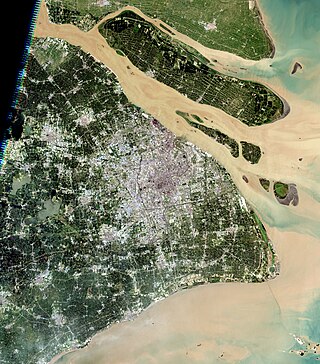
The geography of Shanghai is characterised by its location on the Yangtze River Delta on China's east coast and its proximity to the Pacific Ocean via the East China Sea. The city is centred on the Huangpu River, a tributary of the Yangtze River, and extends outwards in all directions, with the suburbs and satellite towns reaching east to the East China Sea, north and west to Jiangsu province, and south to Zhejiang province over Hangzhou Bay.

Jinqiao is a town of Pudong, Shanghai, China. It is in the middle of Pudong, with Zhangjiang Hi-Tech Park on its south, Huangpu River at its north, overlooking Lujiazui Financial and Trade Center to its west. On its north side, is Waigaoqiao Free Trade Zone and harbor. Jinqiao has a national development zone - Jinqiao Export Processing Zone. The area contains a relatively high proportion of foreign nationals and is notable for its large number of International Schools and comfortable environment.
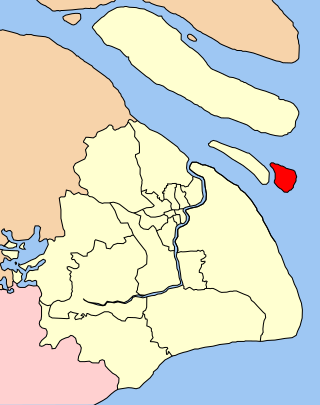
Hengsha is a low-lying alluvial island at the mouth of the Yangtze River in eastern China. Together with the islands of Chongming and Changxing, it forms Chongming District, the northernmost area of the provincial-level municipality of Shanghai. Its population was 33,400 in 2008.

East Huaxia Road is a station on Line 2 of the Shanghai Metro. Located along the Huaxia Elevated Road, it is between the Middle Chuangxin Road and Chuansha stations on Line 2. It came into operation on April 8, 2010 as part of an eastward extension from Guanglan Road to Pudong International Airport.

Chuansha is a station on Line 2 of the Shanghai Metro, located in the town of Chuanxinsha, Pudong. This station is part of the eastward extension from Guanglan Road to Pudong International Airport that opened on 8 April 2010.
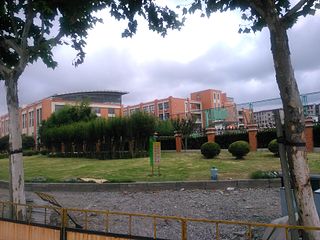
Gaoqiao is a town in Pudong New Area in Shanghai, China. Gaoqiao Old Town dates back to the Southern Song Dynasty. Gaoqiao New Town, also known as Holland Village or Holland Town, is a new town with a Dutch architectural theme.

Shanghai Expo Park is a park in the district of Pudong within Shanghai. It is situated in Pudong New Area. It is located near the Mercedes-Benz Arena.

The Dapu Road Tunnel, formerly Huangpu River Tunnel or Project 651, is a road tunnel that runs under the Huangpu River in the city of Shanghai, China. It connects Huangpu District on the Puxi side of Shanghai with Pudong New Area. It consists of two tubes, the first of which was constructed between 1965 and 1970 and acted as the first vehicular tunnel underneath the Huangpu River in. The tunnel has two lanes and originally operated with one lane in each direction. Due to the need for greater capacity brought on by Shanghai's Expo 2010, a second tube was built between 2009 and 2010 just to the west of the first, opening on February 11, 2010. When the second tube opened, the first tube was converted for northbound traffic only while the new tube carried southbound traffic. The east, northbound tube is 2.739 km (1.702 mi) in length, while the west, southbound tube is 2.971 km (1.846 mi) long.


















